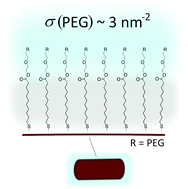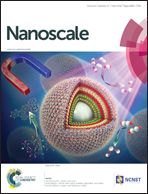Effective PEGylation of gold nanorods†
Abstract
Standard procedures to coat gold nanorods (AuNR) with poly(ethylene glycol) (PEG)-based ligands are not reliable and high PEG-grafting densities are not achieved. In this work, the ligand exchange of AuNR with PEGMUA, a tailored PEG-ligand bearing a C10 alkylene spacer, is studied. PEGMUA provides AuNR with very high stability against oxidative etching with cyanide. This etching reaction is utilized to study the ligand exchange in detail. Ligand exchange is faster, less ligand consuming and more reproducible with assisting chloroform extraction. Compared to PEG ligands commonly used, PEGMUA provides much higher colloidal and chemical stability. Further analyses based on NMR-, IR- and UV/Vis-spectroscopy reveal that significantly higher PEG-grafting densities, up to ∼3 nm−2, are obtained with PEGMUA. This demonstrates how the molecular structure of the PEG ligand can be used to dramatically improve the ligand exchange and to synthesize PEGylated AuNR with high chemical and colloidal stability and high PEG grafting densities. Such AuNR are especially interesting for applications in nanomedicine.



 Please wait while we load your content...
Please wait while we load your content...